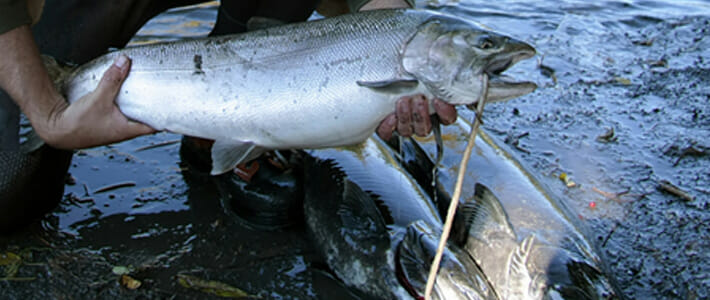Steelhead

Steelhead are usually dark-olive in color, shading to silvery-white on the underside with a heavily speckled body and a pink to red stripe running along their sides.
The steelhead is a sea-run rainbow trout usually returning to freshwater to spawn after 2 to 3 years at sea. In other words, rainbow trout and steelhead trout are the same species. The fish is sometimes called a salmon trout.
Like salmon, steelhead are anadromous: they return to their original hatching ground to spawn. Similar to Atlantic salmon, but unlike their Pacific salmon kin, steelhead are iteroparous (able to spawn several times, each time separated by months) and make several spawning trips between fresh and salt water.
Product pdf for download-
3 oz (100g) raw edible portion
-
Calories 138
-
Total Fat 5.4g
-
Cholesterol 59mg
-
Omega-3 0.986g
-
Sodium 35mg
-
Protein 20.87g
Specs
Steelhead trout can reach up to 55 pounds (25 kg) in weight and 45 inches (120 cm) in length, though average size is much smaller.
Interesting Fact
Salmon and steelhead that are born in freshwater spend time in rivers and streams as little fish eating bugs that allow them to grow larger. After spawning the fish die and are eaten by bugs, closing a loop in the food chain.
Alternatives
Salmon
Source
Most steelhead on the market are farm-raised in Chile and Canada.
In the wild, steelhead are found in the U.S. along the entire Pacific Coast. Worldwide, steelhead are naturally found in the Western Pacific south through the Kamchatka peninsula. They have been introduced worldwide. The species has been introduced for food or sport to at least 45 countries, and every continent except Antarctica. Steelhead were historically around the North Pacific Ocean from northwestern Mexico in North America to eastern Russia in Asia.
Harvest Method
Farmed steelhead are raised in net pens or cages in saltwater like Atlantic salmon.
Eco Details
Farming operations for steelhead (saltwater rainbow trout) are similar to those for raising Atlantic salmon and present many of the same environmental problems.
Steelhead are raised in open-water net pens that can be ripped open by storms or predators, allowing fish to escape. Wastes such as uneaten feed can pollute surrounding waters.
Flavor
Steelhead meat is pink like that of salmon, and is more flavorful than the light-colored meat of rainbow trout.
Texture
The flesh has medium flakes and a tender texture.
Preparation
Grilling is one of the most common methods used to prepare steelhead.
Market Segments
This fish is appropriate in the casual dining, fine dining, hotel, and resort/club segments of the market.